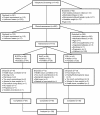Plasma fatty acid changes following consumption of dietary oils containing n-3, n-6, and n-9 fatty acids at different proportions: preliminary findings of the Canola Oil Multicenter Intervention Trial (COMIT)
- PMID: 24754911
- PMCID: PMC4016633
- DOI: 10.1186/1745-6215-15-136
Plasma fatty acid changes following consumption of dietary oils containing n-3, n-6, and n-9 fatty acids at different proportions: preliminary findings of the Canola Oil Multicenter Intervention Trial (COMIT)
Abstract
Background: The Canola Oil Multicenter Intervention Trial (COMIT) was a randomized controlled crossover study designed to evaluate the effects of five diets that provided different oils and/or oil blends on cardiovascular disease (CVD) risk factors in individuals with abdominal obesity. The present objective is to report preliminary findings on plasma fatty acid profiles in volunteers with abdominal obesity, following the consumption of diets enriched with n-3, n-6 and n-9 fatty acids.
Methods: COMIT was conducted at three clinical sites, Winnipeg, Manitoba, Canada, Québec City, Québec, Canada and University Park, Pennsylvania, United States. Inclusion criteria were at least one of the followings: waist circumference (≥90 cm for males and ≥84 cm for females), and at least one other criterion: triglycerides ≥1.7 mmol/L, high density lipoprotein cholesterol <1 mmol/L (males) or <1.3 mmol/L (females), blood pressure ≥130 mmHg (systolic) and/or ≥85 mmHg (diastolic), and glucose ≥5.5 mmol/L. Weight-maintaining diets that included shakes with one of the dietary oil blends were provided during each of the five 30-day dietary phases. Dietary phases were separated by four-week washout periods. Treatment oils were canola oil, high oleic canola oil, high oleic canola oil enriched with docosahexaenoic acid (DHA), flax oil and safflower oil blend, and corn oil and safflower oil blend. A per protocol approach with a mixed model analysis was decided to be appropriate for data analysis.
Results: One hundred and seventy volunteers were randomized and 130 completed the study with a dropout rate of 23.5%. The mean plasma total DHA concentrations, which were analyzed among all participants as a measure of adherence, increased by more than 100% in the DHA-enriched phase, compared to other phases, demonstrating excellent dietary adherence.
Conclusions: Recruitment and retention strategies were effective in achieving a sufficient number of participants who completed the study protocol to enable sufficient statistical power to resolve small differences in outcome measures. It is expected that the study will generate important data thereby enhancing our understanding of the effects of n-3, n-6, and n-9 fatty acid-containing oils on CVD risks.
Trial registration: ClinicalTrials.gov NCT01351012.
Figures

Similar articles
-
High-oleic canola oil consumption enriches LDL particle cholesteryl oleate content and reduces LDL proteoglycan binding in humans.Atherosclerosis. 2015 Feb;238(2):231-8. doi: 10.1016/j.atherosclerosis.2014.12.010. Epub 2014 Dec 9. Atherosclerosis. 2015. PMID: 25528432 Free PMC article. Clinical Trial.
-
DHA-enriched high-oleic acid canola oil improves lipid profile and lowers predicted cardiovascular disease risk in the canola oil multicenter randomized controlled trial.Am J Clin Nutr. 2014 Jul;100(1):88-97. doi: 10.3945/ajcn.113.081133. Epub 2014 May 14. Am J Clin Nutr. 2014. PMID: 24829493 Free PMC article. Clinical Trial.
-
Effects of canola and high-oleic-acid canola oils on abdominal fat mass in individuals with central obesity.Obesity (Silver Spring). 2016 Nov;24(11):2261-2268. doi: 10.1002/oby.21584. Obesity (Silver Spring). 2016. PMID: 27804268 Free PMC article. Clinical Trial.
-
The Effects of Linoleic Acid Consumption on Lipid Risk Markers for Cardiovascular Disease in Healthy Individuals: A Review of Human Intervention Trials.Nutrients. 2020 Aug 4;12(8):2329. doi: 10.3390/nu12082329. Nutrients. 2020. PMID: 32759714 Free PMC article. Review.
-
Novel high-oleic oil consumption for cardiometabolic health: a narrative review.Crit Rev Food Sci Nutr. 2024;64(29):10903-10911. doi: 10.1080/10408398.2023.2283719. Epub 2023 Dec 9. Crit Rev Food Sci Nutr. 2024. PMID: 38069579 Review.
Cited by
-
Docosahexaenoic Acid Attenuates Cardiovascular Risk Factors via a Decline in Proprotein Convertase Subtilisin/Kexin Type 9 (PCSK9) Plasma Levels.Lipids. 2016 Jan;51(1):75-83. doi: 10.1007/s11745-015-4099-4. Epub 2015 Nov 30. Lipids. 2016. PMID: 26620373 Clinical Trial.
-
High-oleic canola oil consumption enriches LDL particle cholesteryl oleate content and reduces LDL proteoglycan binding in humans.Atherosclerosis. 2015 Feb;238(2):231-8. doi: 10.1016/j.atherosclerosis.2014.12.010. Epub 2014 Dec 9. Atherosclerosis. 2015. PMID: 25528432 Free PMC article. Clinical Trial.
-
Interactions between Obesity Status and Dietary Intake of Monounsaturated and Polyunsaturated Oils on Human Gut Microbiome Profiles in the Canola Oil Multicenter Intervention Trial (COMIT).Front Microbiol. 2016 Oct 10;7:1612. doi: 10.3389/fmicb.2016.01612. eCollection 2016. Front Microbiol. 2016. PMID: 27777570 Free PMC article.
-
The Influence of Different Fat Sources on Steatohepatitis and Fibrosis Development in the Western Diet Mouse Model of Non-alcoholic Steatohepatitis (NASH).Front Physiol. 2019 Jun 25;10:770. doi: 10.3389/fphys.2019.00770. eCollection 2019. Front Physiol. 2019. PMID: 31293441 Free PMC article.
-
Best practices for the design, laboratory analysis, and reporting of trials involving fatty acids.Am J Clin Nutr. 2018 Aug 1;108(2):211-227. doi: 10.1093/ajcn/nqy089. Am J Clin Nutr. 2018. PMID: 29931035 Free PMC article.
References
-
- Slattery ML, Randall DE. Trends in coronary heart disease mortality and food consumption in the United States between 1909 and 1980. Am J Clin Nutr. 1988;47:1060–1067. - PubMed
-
- Rasmussen BM, Vessby B, Uusitupa M, Berglund L, Pedersen E, Riccardi G, Rivellese AA, Tapsell L, Hermansen K. Effects of dietary saturated, monounsaturated, and n-3 fatty acids on blood pressure in healthy subjects. Am J Clin Nutr. 2006;83:221–226. - PubMed
-
- Rivellese AA, Maffettone A, Vessby B, Uusitupa M, Hermansen K, Berglund L, Louheranta A, Meyer BJ, Riccardi G. Effects of dietary saturated, monounsaturated and n-3 fatty acids on fasting lipoproteins, LDL size and post-prandial lipid metabolism in healthy subjects. Atherosclerosis. 2003;167:149–158. doi: 10.1016/S0021-9150(02)00424-0. - DOI - PubMed
Publication types
MeSH terms
Substances
Associated data
Grants and funding
LinkOut - more resources
Full Text Sources
Other Literature Sources
Medical

